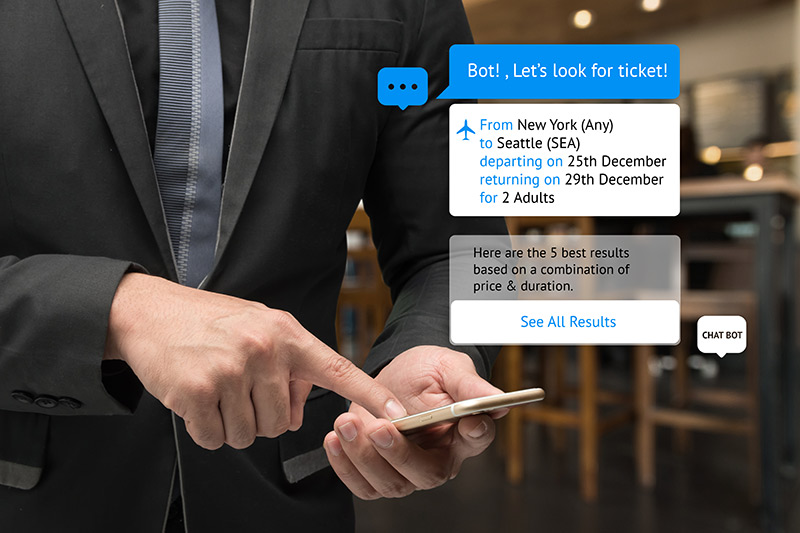Artificial intelligence (AI) is the latest buzzword in the business world. Organizations are looking to AI to do everything from automating help desk responses to speeding up the development of life-saving drugs. It's true that artificial intelligence has the potential to transform business processes and outcomes, but AI isn't the answer to all of life's problems and the technology needs to evolve a lot before it can identify a cure for cancer.
Nevertheless, AI in its current form can make meaningful improvements to business results when the right AI solution is matched to the right task. Organizations are currently and successfully using artificial intelligence for process automation, data analysis, and to interact with customers and employees.
All three of those uses are highly relevant to customer service operations, making contact centers a favorite sandbox for testing out the potential of AI. Contact centers are ripe with huge amounts of complex data that can benefit from the insights provided by AI-powered analytics software. Additionally, AI has some interesting applications for improving CX and agent productivity and effectiveness.
If you're a contact center professional you've likely heard much of this before. You might also be asking, "Where's the beef?" Many articles about contact center AI are long on philosophy and short on practical examples. This article will show you the "beef" by describing five ways artificial intelligence can be used right now to improve contact center performance and CX. After reading the article, you'll have a clearer understanding of how matching the right AI solution to the right task can begin the transformation of your customer service operation.
5 can't miss use cases for contact center AI
Industry-leading contact center software vendors are incorporating AI into their applications at a rapid pace. Currently, artificial intelligence is being used to make forecasts more accurate, help leaders proactively identify and manage problems, provide customers with effective self-service options, and so much more. Let's take a closer look at five real-world use cases.
AI use case #1: Self-service
Interactive voice response (IVR) self-service has come a long way from the days of "press 1 for sales." So has the intent of offering self-service. Early IVR self-service implementations focused on keeping callers away from agents in an effort to reduce labor costs. This often left customers lost in a confusing maze of menu options with no solutions to their issues in sight.
These days, customer-focused organizations view self-service as a channel that can provide convenient and satisfying experiences. They design and optimize self-service so that customers can successfully solve their own issues or easily transfer to an agent for additional assistance. This focus on making IVR self-service more effective and customer-friendly is paying off. Our 2020 benchmark research revealed that, for the first time, self-service channels had higher first contact resolution (FCR) rates than agent-assisted methods - 62% vs. 55%.
With these results, it's not surprising that Contact Pipeline research determined that nearly 25% of contact centers plan to invest in their self-service capabilities in the near future, making it the top investment category.
Credit these results to user-centered design and management supported by artificial intelligence. Natural language processing (NLP), a form of AI, has transformed how users interact with IVR systems. Callers no longer have to "press 1" for anything. Instead, they can simply say what they need. NLP enables the system to understand what they're saying and speak back to them in order to answer their question, guide them through self-service steps, or connect them to an agent. Thanks to AI, this is a more natural experience than pressing buttons on a phone's keypad.
To take IVR self-service to the next level, businesses can also integrate AI-driven virtual agents into their IVRs to create smarter, Siri-like experiences. Our client DSW successfully uses this capability to authenticate callers, a task that agents used to perform. This has decreased handle times by two minutes and substantially increased customer satisfaction.
The DSW story is a good example of using self-service to increase capacity and satisfy customers. As noted in a Forbes article, "[E]nterprise executives today cite customer experience as their No. 1 reason for investing in AI." Allocating funds to implement or improve AI-infused IVR self-service can result in satisfying CX and deliver operational efficiencies.
AI use case #2: Agent assist
This scenario may sound familiar: Agent Adam handled a particularly rough call on Monday in which he and the customer both got a little angry. The call is discovered on Friday during the routine quality monitoring process. Adam receives coaching about the call, but he's taken at least 150 calls since then and doesn't remember the details. Plus, it's too late to change the outcome of the interaction by this point. You're left wondering if Adam mishandled any of those other 150 calls. And did your business lose the customer from Monday’s call?
The typical quality monitoring process can provide outcomes that are "a day late and a dollar short." Relying on small, random samples may not identify everything that needs to be coached. For example, Adam's rough call may have gone undetected and his undesirable behavior might have continued. And feedback becomes less effective as the time between the event and the coaching session increases.
A new, creative use of AI addresses these deficiencies. Real-time interaction guidance leverages artificial intelligence to listen to and analyze each call as it’s happening. It then provides real-time feedback to agents about their soft skills. For example, if the interaction guidance tool determines a caller is stressed out, it could remind the agent to show empathy. And if the agent repeatedly interrupts a customer, the system could tell the agent to use active listening skills. Real-time, AI-enabled coaching can help rescue tense interactions, delivers immediate feedback, and can help correct suboptimal behavior before it has a chance to perpetuate.
The positive impact AI can have on agent performance isn't limited to real-time interaction guidance. The ability to listen to and understand voice interactions means AI-powered solutions can also assist agents with problem-solving. For example, the AI assistant could hear that a caller has a question about software functionality and automatically fetch the relevant knowledge base article for the agent. Intelligent agent assistants can help improve first contact resolution rates, increase accuracy, and reduce handle times, all of which will improve CX.
One additional impact artificial intelligence can have on agents is related to the self-service capabilities already discussed. AI-powered self-service is most effective when used to handle narrowly defined, predictable tasks such as authenticating callers or providing account balances. As more of these routine tasks are handled by self-service, the mix of interactions handled by agents will shift and become more complex. Many agents will find it more engaging and satisfying to spend their time on value-added problem solving rather than on mundane, repetitive tasks.
AI use case #3: Forecasting and scheduling
Forecasting and scheduling might not be the first things that come to mind when you think of contact center AI, but this particular use case makes complete sense when you consider that artificial intelligence is highly suited for analyzing vast quantities of data to identify patterns and make predictions.
Forecasts are typically based on a couple of years of historical volume data. The forecasting process can become quite complex when you factor in historical data by time increment and channel, and also try to determine the best forecasting algorithm to apply. Putting AI to work on forecasting is like throwing a juicy steak to a hungry dog - AI will be "happy" and finish the task in no time.
Artificial intelligence can be particularly helpful when identifying the best algorithm to use. As you may know, there are several forecasting algorithms to choose from, each with their own strengths and weaknesses and each more effective in specific situations than the others. Picking the right algorithm can take a good understanding of data science. This is where artificial intelligence comes in. Workforce management software that's infused with AI can be the "data scientist" that selects the best algorithm for your contact center's unique characteristics. It's a great example of how artificial intelligence can augment a human team's skills.
Artificial intelligence makes forecasts more accurate, and since agent schedules are based on forecasts, the scheduling process receives some downstream benefits from AI. But the benefits aren't just indirect - AI can also be found in some scheduling tools. Scheduling software that leverages artificial intelligence meets business and customer needs by ensuring the right number of skilled agents are scheduled at the right times while also accommodating agent preferences. And because of the AI, the schedules get better with every run.
Everyone benefits when AI facilitates more accurate forecasting and scheduling. Customers, in general, don't have to wait long to speak or chat with agents; agents aren't overwhelmed by volume and should be more satisfied with their schedules, and businesses can better manage labor costs and strengthen customer relationships by being more readily available.
AI use case #4: Chatbots and virtual agents

To many people, contact center AI = chatbots and virtual agents. Even though everything we've already discussed illustrates there's much more to AI than bots, a use case conversation that omits bots would be incomplete. When designed properly and applied to the right tasks, chatbots and virtual agents can provide substantial benefits to operations and CX.
What's the difference between a chatbot and a virtual agent? A chatbot is simpler than a virtual agent and relies on user-configured rules. For example, a chatbot will typically interact with a person by presenting two or three options to click on. The selection will determine the next set of options or responses, and so on. A chatbot may or may not use AI.
In contrast, virtual agents use artificial intelligence, natural language processing, machine learning, and related technologies to understand human speech and intent. This makes virtual agents capable of handling more complex interactions than a rules-based chatbot.
Chatbots and virtual agents are being used successfully in multiple channels, including voice, chat, and messaging apps. They're most successful at handling narrow, well-defined transactions, such as answering frequently asked questions, scheduling appointments, resetting passwords, and providing order status. Chatbots and virtual agents can be an operational boon because they provide 24/7 support and can handle hundreds or thousands of simultaneous interactions, which allows contact centers to quickly scale up their capacity.
On the flip side, a poorly designed chatbot or virtual agent can cause significant CX issues. To mitigate the risk of introducing something that may damage customer relationships, organizations should pilot these new capabilities and start them off by handling one or two simple transactions. If successful, more responsibilities can be added over time.
AI use case #5: Supervisor productivity and effectiveness
Ask most contact center supervisors how they spend their days and they would probably say they do too much firefighting and not enough agent coaching or proactive operational analysis. We've already discussed how artificial intelligence can help supplement supervisor coaching, now let's review how AI analytics can provide actionable insights about performance.
AI-powered interaction analytics can be the data analyst every supervisor and manager needs, on steroids. Interaction analytics software can rapidly comb through and analyze all interactions from voice and digital channels, developing insights about customer sentiment, trending topics, contact drivers, emerging problems, and more. This allows supervisors, for example, to proactively resolve a new issue before it becomes another fire they have to fight.
Additionally, quality management analytics can make the quality monitoring process more efficient and accurate for those supervisors that play a role in pulling and evaluating interaction samples. Quality management analytics software analyzes and categorizes interactions, making it much easier to pinpoint the right ones to evaluate. Plus, this analytics solution enables efficient problem solving by allowing supervisors to target the analysis of specific interaction types - for example, short calls.
The AI-infused forecasting and scheduling capabilities previously discussed will also reduce time-consuming supervisory tasks. More accurate forecasts will help ensure teams are adequately staffed so supervisors don't have to contend with agent burnout and apologizing for bad service levels to upset customers. And smart schedules that accommodate agent preferences will reduce time spent handling agent complaints and adjusting schedules.
Gartner predicts a 25% efficiency gain for customer service organizations that adopt AI. That can include using AI to help supervisors be more productive.
Learn more about contact center AI
If you're interested in learning more about how artificial intelligence is transforming contact centers, read our complimentary white paper, The Inner Circle Guide to AI, Chatbots & Machine Learning. It provides insights about leading-edge AI solutions, including how to implement them in your contact center.
Additionally, we've curated a collection of AI resources specially designed for contact center professionals. Visit our AI resource page to learn more about the power of artificial intelligence.





